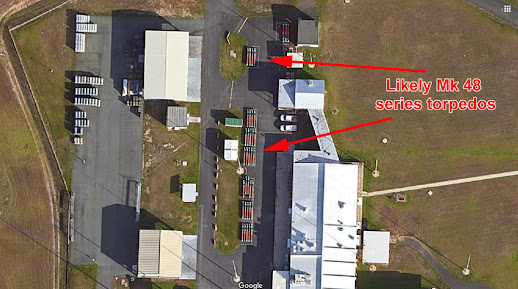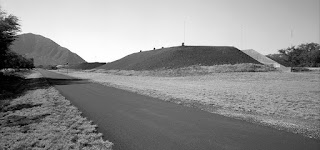Compiled History by Ewa Historian John Bond
Lualualei: Why Are Munitions Being Transferred to
West Loch and Large New Missile Magazines
Being Built by Army and Navy?
Lualualei Naval Magazine
This is Lualualei in leeward Oahu. This naval magazine has gradually been shut down and the last tenant is the US Army which has been keeping its munitions there. Now the army plans to remove all remaining munitions over to a new Army Munitions Complex directly next to the communities of West Loch, Ewa by Gentry, Ewa Villages and Ewa Beach.
The Army is also building many new Type D missile magazines for new missiles and long range artillery shells at West Loch. The Navy is also building new Type D missile magazines at West Loch. There are major new weapons being developed largely in anticipation of the coming war with China. China’s military is making increasingly aggressive military moves in the Pacific with Guam and Hawaii in their bomb sites. The US Military is countering this with a rapid buildup of advanced new missiles to hit ship and island targets in the Pacific.
Cost of Compliance on Graduate School of Business & Public Policy Thesis, December 2017, Naval Postgraduate School, Munitions Consolidation from Lualualei to West Loch
https://calhoun.nps.edu/handle/10945/58904
In 1967, the Naval Ordnance Safety and Security Activity (NOSSA) came out with more restrictive safety standards mandating that the distance between each magazine must be greater than what is currently installed at West Loch (NAVSEA, 2017). Due to the lack of permissible net explosive weight (NEW) allowed per the NOSSA standards, Navy Munitions Command has been using several magazines in Lualualei to store smaller-sized ordnance.
The 1995 Hawaii Military Land Use Master Plan (HMLUMP) recognized the importance of Hawaii’s strategic location as a “bridge to Asia” and, as a result, recommended the release of the Lualualei Annex due to its aging magazines and its consolidation with West Loch pending construction of new facilities.
The 2002 Commander, Navy Region Hawaii (CNRH) Ordnance Facilities Plan, proposed a significant investment in new ordnance infrastructure for new magazines near West Loch. Additionally, in 2003, PACFLT identified that only four out of 299 magazines in Hawaii are capable of storing modern missiles for naval destroyers and submarines.
The two courses of action according to the Navy’s analysis are as follows: Option 1. Navy builds new magazines, Army builds new magazines, and both consolidate in West Loch in accordance with NOSSA standards. Option 2. Current magazines at Lualualei are upgraded to NOSSA standards and current operations remain the same for Navy and Army. Option 1 may sound reasonable but does not take in account the required ESQD – safety zone, according to information made available to the public in 2018 by the Army MOTSU presentations. The Army munitions complex will be just .5 (1/2 mile) from the nearby communities.
Rising tensions in the Pacific with China, North Korea, and Russia could lead to combat operations in the Pacific. The West Loch Hawaii’s will need to store additional prepositioned munitions, hold ordnance for ships undergoing repairs, and resupply more deploying ships to the Pacific. The West Loch channel has already been expanded to handle large newer Navy ammunition ships, such as handled by the Army MOTSU site in North Carolina which has a 3.5 mile ESQD safety arc, compared to West Loch which has a very much smaller ESQD and is located right next to many suburban homes in Ewa West Oahu.
See Figure 3 below for the layout of West Loch and shows the explosive safety boundaries associated with ammunition operations. Unlike Lualualei, West Loch is closer to residential areas. Ordnance operations in both Lualualei and West Loch are contracted out and are renewed annually by the Navy.
https://www.globalsecurity.org/military/facility/lualualei.htm
Global Security: Naval Magazine, Lualualei May 2011
The Naval Magazine is located in Lualualei Valley on the leeward side of Oahu, with headquarters a few miles inland from the towns of Waianae and Nanakuli. The shipping and receiving center is located at West Loch. The Naval Magazine is a terminus for the kolekole Pass road which traverses the beautiful Waianae Mountains. The drive extends from the Waianae coast to Schofield Barracks and offers panoramic views. The road is closed to the public, but open to military personnel and their dependents on most days until sunset.
In January 2000 the designation Naval Magazine, Lualualei, Hawaii, was changed to Naval Magazine Pearl Harbor. The name change was a result of the command's recent headquarters move from the Lualualei Branch to Pearl Harbor's West Loch. Fifty W-80-0 munitions for Tomahawk SLCM's and 40 nuclear aerial bombs are stored in the Lualualei Naval Magazine (NAVMAG) at West Loch on Oahu, Hawaii.
In January 2000 Naval Magazine Lualualei held its official ribbon-cutting ceremony for the grand opening of the new headquarters building, located in the West Loch Branch, Ewa Beach. The Commanding Officer, Capt. Shawn Morrissey, kicked off the ceremony with an introductory speech. Following his speech, Lt. Leila Havadtoy provided a blessing for the new headquarters building. After the ribbon was officially cut, all attendees gathered together for a potluck barn-warming celebration, which was held right next to the waterfront and the headquarters.
Lualualei is located on land that consists of a thin layer of alluvial and coastal sediments and reef deposits overlying consolidated limestone. Civilian land use surrounding this facility is largely rural and the site is surrounded by agricultural and small areas of Urban and Conservation Land Use districts. Naval Magazine Lualualei, which occupies 8,105 acres of the valley. The nearest urban area is the town of Maili, which lies approximately 1 mile west of the station. The towns of Waianae and Nanakuli are also located nearby. Kolekole Pass is a narrow mountain road across the Waianae Mountain Ranges that provides vehicular access to Schofield Barracks. Lualualei is approximately 27 miles from downtown Honolulu.
http://archives.starbulletin.com/98/10/05/news/story1.html
The Navy owns more than 9,000 acres in the Waianae Valley. Its radio towers are a familiar sight, but more goes on beneath the earth.
The Navy has used Lualualei as an ammunition depot (initially Naval Ammunition Depot Oʻahu, now Naval Magazine Pearl Harbor) and a communications facility (Lualualei Naval Radio Transmitting Facility) since 1934.
Kolekole Pass forms a low crossing point through the Waiʻanae Mountains. A prehistoric trail crossed Kolekole pass linking Waiʻanae Uka with Waiʻanae Kai.
Kolekole Pass Road is located on the federal lands connecting these military facilities on Waiʻanae coast of Oʻahu to Schofield Barracks Army Installation in Central Oahu. The Army's 3rd Engineers corps constructed vehicular passage in 1937.
The Magazine facility, a terminus for the Kolekole Pass road, contains 255 aboveground storage structures capable of housing 78,000 tons of ammunition and explosives. (hawaii.gov) The shipping and receiving center is located at West Loch, Pearl Harbor.
Historic documentation Of Lualualei Ammunition facility

































